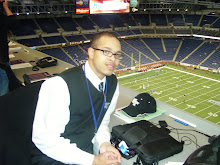
Good day from St. Louis, MO! The home of the Arch, TUMS, toasted ravioli, and Anheuser-Busch is my second stop on a two-week road trip to learn and have some fun. This part of the rip finds me at a conference titled “Covering Sports in a Twitter world.”
For many readers of this blog, you already know that these days, this is common practice. A month ago, I was covering MT’s baseball team for the newspaper and providing in-game updates using my Twitter account. If you were watching the NBA or NHL Championships, reporters from around the country would share their opinions of the teams involved. Even fans shared their passion for the teams involved and not involved (Atlanta Hawks in 2010!).
Today, technology is changing so much that it’s almost comical that we were once in this position: http://www.youtube.com/watch?v=5WCTn4FljUQ
The purpose of me being at this conference is to find out better ways I can inform you as a reader and viewer. Between the newspaper’s print and online editions, my blog, and my Twitter account, there are plenty of opportunities for me to let you know about what’s going on in the world of sports (MT or otherwise). But the limits do exist. The average sports fan is an ESPN viewer and is used to 24/7 coverage that several hundred people dedicate their days towards. In my case, it’s just me. So it is up to me to find a way to replicate as close as possible the work that local TV/radio/newspapers can do.
One of those ways is to stick to journalism basics. No matter how big a station or newspaper is, nothing can replace efficient reporting. Put your priorities in order. Is your media organization more concerned with breaking the story or covering it the best way possible? In Sidelines and MTTV’s case, it’s a little of both. There’s nothing like saying “we brought you this story first” but we have to make sure all of our facts are accurate. Media organizations have lost credibility because they decided to take a leap of faith without having all of the facts. Instead of leaving the holes unfilled until the facts come through, they make guesses or rely on hearsay.
It turns the average sports fan into a cautious sports fan. And it should.
Parents around the world teach their kids to don’t believe everything people tell them. Fans have to be willing to do their own research at times instead of relying on certain web sites to be their only source of news. There are times where I will break stories on my Twitter account and write the story for Sidelines’ online edition. This can be very effective as long as your focus is on the story and not so much the competition. Nobody wants to be late on a story but nobody wants to be wrong either….
Many more thoughts will come up during this conference so expect at least one more blog today, and it may be late. For now in memory of my favorite artist of all-time, Michael Jackson, I present to you his super bowl halftime show: http://www.youtube.com/watch?v=8HbTjFn7KjE
